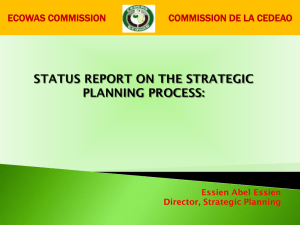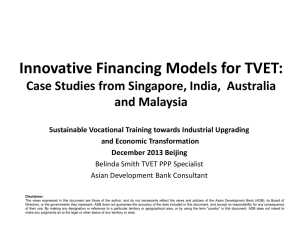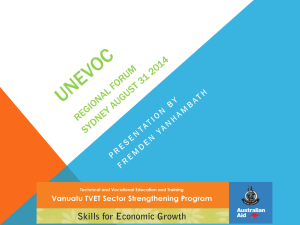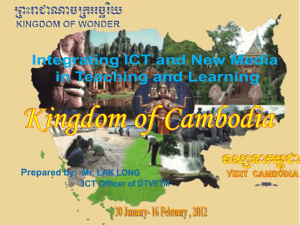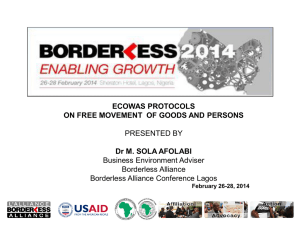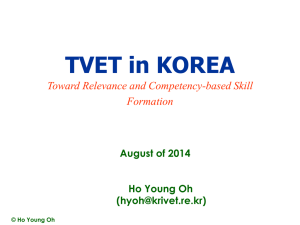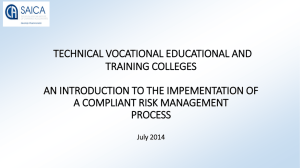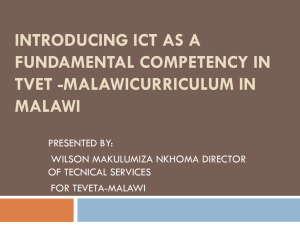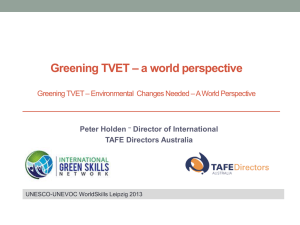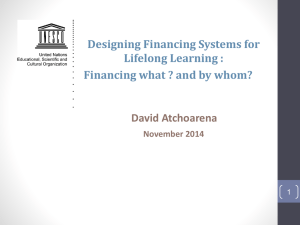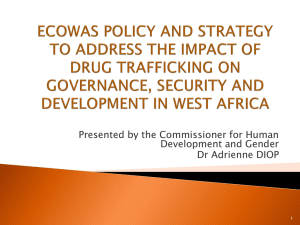(TVET) under the Economic Community of West African
advertisement
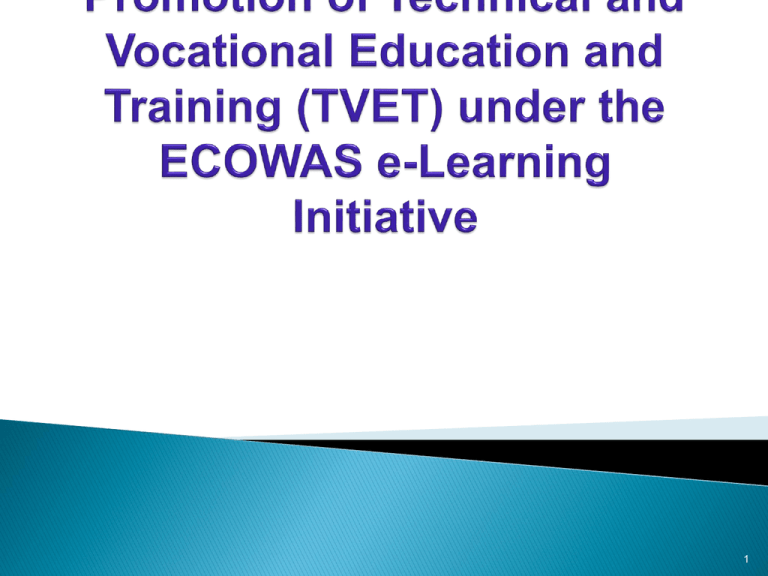
1 Background information General education situation Needs to Address Rescue measures Highlights of the status report of TVET Highlights of recommendations for TVET revitalization Unified Format for Learning Teaching and Training Materials (LTTM) Training of Trainers ECOWAS Policy Implementation Documents The Way Forward Partnerships 2 Established by our founding fathers on 28th of May 1975, in Lagos, Nigeria Composed of 15 West African Countries (8 Francophone, 5 Anglophone & 2 Luxophone countries). With a population of 290 million in 2008 Accounts for 4.6% of the world population and over 40% of that of sub-Saharan Africa Land area (5,110,914 km2), stretches from the Cape Verde archipelago in the West to Nigeria in the East. Therefore the most populated Regional Community in the Continent 4 The Vision of ECOWAS towards an ECOWAS Peoples as against ECOWAS of States is to achieve “A region without borders in which the populations can access and are able to Harness its abundant resources by creating Opportunities for the population and sustainable environment”. Equality and Interdependence Inter-state Co-operation Solidarity and collective self-reliance Harmonization of Policies and Programmes. Non-aggression Regional Peace, Stability and Security Peaceful Settlement of Disputes Respect, Promotion and Protection of Human Rights Promotion and Consolidation of Democracy and Good Governance Accountability, Economic and Social Justice. To promote cooperation and integration, leading to the establishment of an Economic and Monetary Union in West Africa in order to raise the living standards of its people, ensure economic growth, foster relations among Member States and contribute to the progress and development of the African Continent. Need to recall the general education situation in Africa – Low enrolment, retention and completion rates High adult illiteracy rate (about 39.7% against average of 23.4% for developing countries) Twin problems of quality and cost of education Gender disparity High teacher-pupil ratio 8 High population of youths (about 60%) Long distances from school Wide disparities between member states as well as between rural and urban areas. Inadequate infrastructure –ICT and others High teacher-pupil/student ratio Outmoded teaching materials Exclusion of people in difficult circumstances High cost of education-gradually becoming the preserve of the rich Unemployment of school leavers 9 Extension of education and training facilities with a bias on ICT facilitated learning as a means of providing skills, removing ignorance and causing a participation in the information society Inclusion of the disadvantaged population Improvement of quality of education through qualified teachers, improved teaching and learning materials and provision of learning and training opportunities Education to meet the socio-economic needs of the learners and the larger society 10 Priority Areas including TVET adopted by the First Conference of Ministers of Education in 2002 Adoption of e-Learning as a further priority by the Second Conference of ECOWAS Ministers of Education in 2004 Inauguration of a regional e-Learning Task Force by the President of ECOWAS Commission in 2006 Survey of e-Learning in 2008 11 Renewed commitment in 2009 of the Third Conference of Ministers of Education and the 36th Ordinary Session of ECOWAS Heads of State and Government to the promotion of TVET Regional consultation that prepared a status report and made recommendations for revitalizing TVET in collaboration with UNESCO-BREDA and other relevant UN agencies and their allies Inauguration of Inter Agency Task Team of TVET partners 12 Identification, acknowledgement and adoption of the outcome of over 10 years of Collaboration between the government of Nigeria and UNESCO on online development and revision of TVET curriculum and Teaching and Learning Materials Development of regional e-learning Policy Statement in 2010 Inauguration of the ECOWAS Committee of Resource Persons for the revitalization of TVET through e-learning 13 All over West Africa, millions of young people leave primary and secondary school without any practical or employable skills to enter the labour market or the ability to earn an income The major challenges relate to a socioeconomic environment that is characterised by slow economic growth, high population growth, and a growing number of poorlyeducated and unskilled job-seeking school leavers Ratio of theory in teaching higher than practicals 14 Over the past couple of years, some countries have taken steps to streamline and harmonize their TVET delivery systems by enacting appropriate laws and regulations. However progress is slow TVET in most ECOWAS countries still suffer from inadequate financing, poor management, inadequate qualified teachers, weak organisational structures marginalization and limited use of ICT in the delivery processes lack flexibility, relevance and responsiveness 15 TVET teachers and practitioners do not derive adequate socio-economic benefit from their services Recruitment of qualified TVET teachers cannot match the better remuneration packages offered by industries One possible strategy to improve the practical skills and retain the services of qualified teachers is to arrange periodic upgrading courses and enterprise-based internships for those at post 16 Curriculum and Learning Materials development and revision Development of Regional and National Qualifications Frameworks Establishment of regional observatories Promotion of apprenticeship and skills training programmes Technical Teacher Training and the Training of Trainers Integration of ICT and entrepreneurship education into TVET 17 The availability of curriculum development experts, skilled instructors and competent teachers with workplace experience is central to the acquisition of employable skills by all categories of learners. After series of consultation, ECOWAS experts adopted the outcome of decades of collaborative efforts with developing countries like Nigeria, Ethiopia, Libya, Djibouti, Bahrain and Iraq to adapt existing practice in Member Statesto the unified format for curriculum and learning materials development and revision 18 The seven columns format which combines all the elements required in curricula are developed using Gloom’s taxonomy of knowledge comprehension, application, analysis, synthesis and evaluation Competency Based Contents General Objectives of subjects reflecting the Job description or Occupational Standards Specific Learning Outcomes Time allocation and breakdown by weeks (e.g. Semester:15 weeks) 19 Detailed Specific Learning Outcome; Suggested Teacher Activity; Required teaching and training Resources for both practicals and theory Assessments Guidelines 40-60% Practical Contents Includes Entrepreneurship and starting small projects Integrated ICT in all subjects as well as basic ICT training. 20 Simple Layout Time Allocation for each learning outcome Clear Coordination and harmonisation of Theory-Practical Readily Converted to Textbook -List of Contents Horizontal & Vertical coordination for al subjects Promotes learner competency and employability 21 Easy Quality Assurance on Implementation Identifies resources and equipment Provides Guidelines for Assessments Affords the teachers opportunity of contributing to curriculum revision Handy for coordination and harmonisation at national and regional levels flexible and adaptable to existing curricula in Member States Promotes the use of animations 22 This entails the development or revision of Learning, Teaching and Training Materials (LTTM ) indicating generic features for all the programmes e.g cover Page with appropriate photos, list of Contents, weekly Content, activities, references First edition of LTTM will be ready for use by teachers and students after being reviewed (Peer Review) and edited for consistency All documents preferably converted to PDF and Compiled on CDs 23 Best to upload to a dedicated Website using open source platform Evaluation and Revision Once implementation of the curricula and the use of LTTM commence, feedback from TVET institutions, Teachers and students regarding suggestions for improvements, new material to be added, and possible inclusion of Animation and Multimedia should be collected and analysed. 24 Role of the teachers remains that of: Developing detailed Personal Lesson Plan & Material Adding Examples & Other Supplementary Material Adding practical exercises & Activities Introducing Animation & Multimedia 25 8 sessions of TOTs were organized for 240 teachers and administrators in 2010 16 Sessions for 480 Participants planned for 2011- 2 sessions for 60 already conducted 26 PIDs developed from the ECOWAS e-learning Policy Document for the promotion of TVET delivery and entrepreneurial skills in Member States Though still undergoing adoption procedure include: Cyber Corps Community Colleges Concept Technical and Vocational Skills and Entrepreneurship Development Career and Professional Development for the Public Service 27 Excellence in E-Learning Awards Career and Professional Development in the Private Sector ICT Entrepreneurship Development E-learning Content Development Training All these projects are designed to be implemented through e-learning bearing in mind critical success factors such as electricity supplies, high cost of bandwidth, infrastructure and general resistance to modern technologies. 28 Adoption of the PS and PIDs by members of Ministers in charge of Education, ICT and Labour in September 2011 Vetting by ECOWAS Parliament Resource Mobilization Establishment of Coordination mechanism Actual implementation of the PIDs Monitoring and Evaluation Implementation of the ECOWAS Roadmap for TVET Revitalization 29 ECOWAS acknowledges the fact that the peculiarities of the challenges confronting eLearning in the region requires divers partnerships and collaboration among key stakeholders ECOWAS acknowledges and appreciates exiting collaboration with national governments, UNESCO and other Sister organizations and their allies, COL, ACCC, EU, ADB, the Private Sector, NGOs and donor organizations 30 THANK YOU JE VOUS REMERCIE MUITO OBRIGADO
